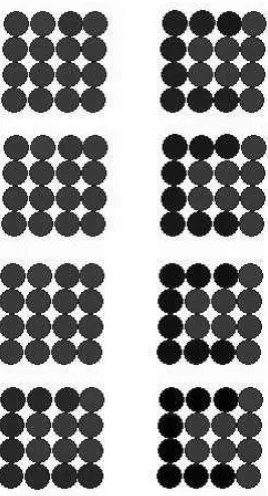Eric Cole
Ronald D. Krutz, Consulting Editor
Hiding in Plain Sight:
Steganography and the Art of
Eric Cole
Ronald D. Krutz, Consulting Editor
Hiding in Plain Sight:
Steganography and the Art of
Editorial Manager: Kathryn Malm
Managing Editor: Angela Smith
Media Development Specialist: Greg Stafford
Text Composition: John Wiley Composition Services
This book is printed on acid-free paper. ∞
Copyright © 2003 by Eric Cole. All rights reserved.
Published by Wiley Publishing, Inc., Indianapolis, Indiana
Published simultaneously in Canada
No part of this publication may be reproduced, stored in a retrieval system, or transmitted
in any form or by any means, electronic, mechanical, photocopying, recording, scanning, or
otherwise, except as permitted under Section 107 or 108 of the 1976 United States Copyright
Act, without either the prior written permission of the Publisher, or authorization through
payment of the appropriate per-copy fee to the Copyright Clearance Center, Inc., 222
Rose-wood Drive, Danvers, MA 01923, (978) 750-8400, fax (978) 646-8700. Requests to the
Pub-lisher for permission should be addressed to the Legal Department, Wiley Publishing, Inc.,
10475 Crosspoint Blvd., Indianapolis, IN 46256, (317) 572-3447, fax (317) 572-4447, E-mail:
[email protected].
Limit of Liability/Disclaimer of Warranty: While the publisher and author have used their
best efforts in preparing this book, they make no representations or warranties with respect
to the accuracy or completeness of the contents of this book and specifically disclaim any
implied warranties of merchantability or fitness for a particular purpose. No warranty may
be created or extended by sales representatives or written sales materials. The advice and
strategies contained herein may not be suitable for your situation. You should consult with
a professional where appropriate. Neither the publisher nor author shall be liable for any
loss of profit or any other commercial damages, including but not limited to special,
inci-dental, consequential, or other damages.
For general information on our other products and services please contact our Customer
Care Department within the United States at (800) 762-2974, outside the United States at
(317) 572-3993 or fax (317) 572-4002.
Trademarks:
Wiley, the Wiley Publishing logo and related trade dress are trademarks or
registered trademarks of Wiley Publishing, Inc., in the United States and other countries,
and may not be used without written permission. All other trademarks are the property of
their respective owners. Wiley Publishing, Inc., is not associated with any product or
ven-dor mentioned in this book.
Wiley also publishes its books in a variety of electronic formats. Some content that appears
in print may not be available in electronic books.
Library of Congress Cataloging-in-Publication Data:
ISBN: 0-471-44449-9
and all New York City Fire Fighters who lost their lives on and after
September 11, 2001. They made the ultimate sacrifice by giving up
their lives so others could live.
I still remember getting the phone call that Kenny was missing, and
it upset me more than words could describe. Kenny was probably one
of the nicest people I had the privilege of knowing, and he would do
anything to help someone else out. That is probably why being a
Acknowledgments
xiii
Introduction
xvii
Part One
Exploring the World of Covert Communication
1
Chapter 1
Covert Communication: It’s All Around You
3
What Is Steganography?
5
Where Hidden Data Hides
5
Where Did It Come From?
6
Where Is It Going?
7
When Steganography Inspires Terror
8
Who Is Using Stego?
9
Protecting Your Rights
10
Keeping Your Business Secure
10
Looking Ahead
12
Chapter 2
Cryptography Explained
13
Cryptography Defined
15
Crypto 101
15
Crypto Lingo
16
Early Cryptography
17
How We Got to Modern Cryptography
18
Cryptography and Network Security
19
Confidentiality 19
Integrity 20
Availability 21
Authentication and Non-Repudiation
22
Authentication 22
Non-repudiation 23
Principles of Cryptography
24
Contents
You Cannot Prove Crypto Is Secure
24
Algorithm versus Implementation
25
Never Trust Proprietary
26
The Strength of an Algorithm Is in the Key
28
Cryptography Stays in Place
28
Cryptography Must Be Designed In
29
All Cryptography Is Crackable, in Time
29
Security Becomes Obsolete
31
Types of Cryptography
32
Symmetric 32
Diffie-Hellman Key Exchange
32
Common Implementations of Symmetric Encryption
34
Asymmetric 38
Hash 38
Putting the Pieces Together
39
Using Cryptography Tools
40
Working with PGP
41
Generating a Privacy Key with PGP
41
How PGP Works with Email
44
Using SSH
45
Looking Ahead
50
Chapter 3
Hiding the Goods with Steganography
51
Overview of Steganography
52
The Growth of Steganography
53
Steganography in Use
54
Flaws of Steganography
55
Variations on Stego
56
Trojan Horses
56
Covert Channels
57
Easter Eggs
58
Hardware Keys
58
Security and Steganography
59
Confidentiality 59
Survivability 59
No Detection
60
Visibility 60
Principles of Steganography
61
Types of Steganography
61
File Type
61
Method of Hiding
62
Hands-on Steganography
62
Putting All the Pieces Together
63
Chapter 4
Digital Watermarking
67
What Is Digital Watermarking?
68
Exploring Uses for Digital Watermarking
69
Properties of Digital Watermarking
71
Types of Digital Watermarking
73
Invisible Watermarking
74
Visible Watermarking
77
Goals of Digital Watermarking
78
Digital Watermarking and Stego
79
Uses of Digital Watermarking
80
Removing Digital Watermarks
81
Looking Ahead
87
Part Two
The Hidden Realm of Steganography
89
Chapter 5
Steganography at Large
91
The Internet: A Climate for Deceit
93
The End of the Paper Trail
93
Your Jurisdiction or Mine?
94
Searching for Identity
95
Corporate Espionage
97
Who’s Playing?
97
Information Attacks
98
System Attacks
99
Playing Spy
99
Big Brother—With an Attitude
99
Information Crime and the Law
101
Who’s Watching Whom?
101
Protecting Ideas
101
Enforcement: A Tough Nut
102
The Challenge
103
Enforcing the Unenforceable
103
The Growing Science of Computer Forensics
104
Looking Ahead
105
Chapter 6
Nuts and Bolts of Steganography
107
Types of Steganography
108
Original Classification Scheme
109
Insertion-Based 109
Algorithmic-Based 109
Grammar-Based 110
New Classification Scheme
111
Color Tables
113
Products That Implement Steganography
114
S-Tools 115
Using S-Tools with Image Files
115
Using S-Tools with Sound Files
116
S-Tools Step-by-Step
117
Hide and Seek
118
J-Steg 119
EZ Stego
121
Image Hide
122
Digital Picture Envelope
123
Camouflage 126
Gif Shuffle
127
Spam Mimic
127
Rolling Your Own Stego
129
Comprehensive Stego Program
130
Technique Structure
132
Areas for Improvement
135
wav-Sine Creation
135
Overview 135
Idea 135
Details 135
Logic Flow
135
Areas for Improvement
136
WAV Twiddle
137
Overview 137
Idea 137
Details 137
Logic Flow
137
Areas for Improvement
139
Doc Stuffer
139
Overview 139
Idea 139
Details 139
Logic Flow
140
Areas for Improvement
141
EXE Stuffer
141
Logic Flow
143
Areas for Improvement
143
HTML White Space
144
Overview 145
Idea 145
Details 145
Logic Flow
147
Areas for Improvement
147
HTML White Space Variable
147
Overview 147
Idea 148
Details 149
Logic Flow
149
Areas for Improvement
149
RTF Insertion
149
Overview 149
Idea 150
Details 151
Logic Flow
151
Areas for Improvement
151
War 151
Overview 151
Idea 151
Details 152
Logic Flow
153
Areas for Improvement
153
Looking Ahead
153
Chapter 7
Sending Stego Files Across a Network
155
Uses and Techniques of Network Stego
155
Hiding in Network Traffic
156
Stego Combined with Viruses
156
Tracking Internet Usage
156
Network Stego Techniques
157
Hiding in an Attachment
157
Hiding Data in an Email Attachment
157
Transmitting Hidden Data with FTP
157
Posting Stego to a Web Site
158
Hiding in a Transmission
158
Using Invisible Secrets to Hide and Transmit Data
158
Embedding Hidden Data with Invisible Secrets
159
Decrypting and Extracting Data with Invisible Secrets
164
CameraShy 167
Hiding Data in Network Headers
169
Networking and TCP/IP: The Basics
169
UDP and ICMP Headers
171
Covert tcp
171
How Covert tcp Works
172
Running Covert tcp
173
Hiding in an Overt Protocol
179
Looking Ahead
181
Part Three Making Your Own Communications Secure
183
Chapter 8
Cracking Stego and Crypto
185
Who’s Cracking What?
186
Cracking Analysis
187
Cryptanalysts 187
Steganalysts 188
The Role of Detection
188
Detecting Encryption
188
Randomness and Compression
190
Detection and Image Files
190
Building a Program for Detection
191
Cracking Cryptography
194
General Attacks
195
Ciphertext-Only Attack (COA)
195
Known Plaintext Attack (KPA)
196
Chosen Plaintext Attack (CTA)
197
Chosen Ciphertext Attack (CCA)
197
Specific Attacks
197
S-Tools Version 4.0
202
Hide and Seek
205
J-Steg 205
EZ Stego
207
StegDetect 208
General Techniques for Detecting Stego
211
Looking Ahead
216
Chapter 9
Developing Your Secure Communications Strategy
217
Secure versus Secret
218
Setting Communication Goals
219
Developing a Strategy
222
Common Problems with Secure Technologies
222
Looking Ahead
225
Chapter 10 The Future of Steganography
227
Improving the Techniques
229
Improved Resistance to Analysis
229
How Much Can You Hide?
229
Improved Attack Tools
230
New and Improved Ways to Use Stego
230
Law Enforcement
230
Corporate Uses
230
Illegal Uses
231
Where Will Stego Tools Reside?
231
Appendix A Steganography Source Code
233
Appendix B What’s on the CD-ROM
315
Sometimes you meet people in the strangest places and build interesting
friendships with them. Ron Krutz is one of those people whom I met awhile
back in a training class, and we continue to stay in touch and communicate. It
is Ron who introduced me to the wonderful people at John Wiley who have
been very helpful and supportive through the process of writing a book. Carol
Long is an insightful and energetic executive editor who was open to
publish-ing a book on such a cuttpublish-ing-edge technology. Nancy Stevenson provided
con-stant guidance and expertise, and without all of her help and hard work, this
book would not be where it is today.
One of the rules I live by is to take good care of your friends because if you
get into trouble they are going to be the ones who help you out. Jim Conley is
one of those friends. When deadlines started getting tight and the code for this
book needed to get finished/written, Jim eagerly agreed and took the bull by
the horns. Jim is an amazing person to know, an amazing friend, and an
amaz-ing coder.
I also want to thank all of my friends at Sytex who give continuous support
and encouragement on a daily basis: Brad, Scott, John, Bryan, Nick, Jon, Matt,
Marty, Dan, Fred, Evan, and Mike. Continuous thanks to Sid Martin and Ralph
Palmieri for understanding the importance of research and for allowing
cre-ative minds to think of solutions to complex technical problems.
There are also my friends like Gary Jackson, Marc Maloof, and the great
peo-ple at SANS who give constant insight and advice.
In terms of continuing this research and creating an environment for creative
learning, I thank Fred Grossman and all of the wonderful people at Pace
Uni-versity for creating a great doctorate program that really focuses on learning.
Acknowledgments
Most of all, I want to thank God for blessing me with a great life and a
won-derful family: Kerry Magee Cole, a loving and supportive wife without whom
none of this would be possible, and my wonderful son Jackson and my
princess Anna, who bring joy and happiness everyday to me. Ron and
Caro-line Cole and Mike and Ronnie Magee have been great parents to me, offering
tons of love and support. And thanks to my wonderful sister, brother-in-law,
and nieces and nephews: Cathy, Tim, Allison, Timmy, and Brianna.
Eric Cole
is the best-selling author of
Hackers Beware
and one of the
highest-rated speaker on the SANS training circuit. Eric has earned rave reviews for
his ability to educate and train network security professionals worldwide. He
has appeared on CNN and has been interviewed on various TV programs
including CBS News and 60 Minutes.
An information security expert for more than 10 years, Eric holds several
professional certificates and helped develop several of the SANS GIAC
certifi-cations and corresponding courses. Eric, who obtained his M.S. in Computer
Science at the New York Institute of Technology, is finishing up his doctorate
degree in network steganography from Pace University.
Eric has created and directed corporate security programs for several large
organizations, built numerous security consulting practices, and worked for
more than five years at the Central Intelligence Agency. Eric is currently Chief
Scientist for The Sytex Group’s Information Warfare Center, where he heads
up cutting-edge research in steganography and various other areas of network
security. He was an adjunct professor at both New York Institute of
Technol-ogy and Georgetown University. Eric has provided expert testimony in many
legal cases, including his work as an expert witness for the FTC in their case
against Microsoft. Eric is a sought-after speaker on the topic of steganography
and other areas of network security.
About the Author
I have always been fascinated by steganography (stego for short), so much so
that I am completing my Ph.D. in that area of study. It is amazing to me to sit
back and reflect about how the field of secret communications and
steganog-raphy has developed and changed over the past 10 years. From a technology
standpoint, this is an exciting time to be alive.
Why I Wrote This Book
I decided to write this book because of a deep frustration I felt after September
11, 2001. In all areas of security, including steganography, the bad guys always
seem to have an upper hand and do a better job at breaking into assets than we
do protecting them.
After September 11, based on briefings and interviews, I became very aware
that a large percent of the population, including many law enforcement
agen-cies, do not even know what steganography is. I wanted to write a book that
would help people understand the threat so that we can take action to
mini-mize the damage going forward.
As you will learn in this book, stego is not a new field. Stego has played a
critical part in secret communication throughout history.
N O T E
If you are ever in Washington, D.C., stop by the newly opened Spy
Museum. I was amazed as I walked through and saw example after example of
stego in action.
Introduction
What’s Covered in This Book
Combining the art of steganography with the powers of computers, networks,
and the Internet has brought this method of hiding information to a whole
new level.
This book is meant to give you a crash introduction to the exciting world of
secret communication. Here’s what’s covered:
■■
In Part One, you learn what steganography is and how it has evolved
over time. You’ll also learn about cryptography and digital
water-marking because those two companion technologies are often used
in concert with steganography.
■■
In Part Two, you discover who is using steganography and explore
some of the ethical and legal challenges we face when detecting and
cracking secret communication. Then you study the nuts and bolts of
using steganography tools and transmitting hidden data over networks.
■■Part Three is where you learn about methods you can use to crack
steganography and cryptography, ideas for keeping your own
commu-nications secure, and the future direction of steganography.
To add even more value to the book, source code for the techniques that are
discussed in Chapters 6 and 8 has been included in Appendix A and on the
accompanying CD so that you can try these techniques out and build your
own stego.
Special Features
In this book there are three special features to look for:
■■
Notes provide additional or background information for the topic at
hand.
■■
Stego in Action Stories are interspersed throughout the book. They
rep-resent fictionalized versions of the kind of secret communication
sce-narios I’ve observed in my years working for the CIA and as a security
consultant.
■■
The CD includes not only source code for steganography techniques
discussed in the book, but also some popular steganography tools and
color versions of images so you can see clearly how images with and
without hidden data appear. You can read all about the contents of the
CD in Appendix B.
One
3
Though security is nothing new, the way that security has become a part of our
daily lives today is unprecedented. From pass codes that we use to enter our
own highly secure homes, to retina-scanning technology that identifies us as
we enter our office buildings, to scanners in airports, we have made security
technology as much a part of our daily lives as the telephone or automobile.
We are also surrounded by a world of secret communication, where people
of all types are transmitting information as innocent as an encrypted credit
card number to an online store and as insidious as a terrorist plot to hijackers.
The schemes that make secret communication possible are not new. Julius
Cae-sar used cryptography to encode political directives. Steganography (commonly
referred to as stego), the art of hidden writing, has also been used for generations.
But the intersection of these schemes with the pervasive use of the Internet,
high-speed computer and transmission technology, and our current world political
climate makes this a unique moment in history for covert communication.
1
Covert Communication:
It’s All Around You
“Uncrackable encryption is allowing terrorists—Hamas, Hezbollah, al Qaeda and
others—to communicate about their criminal intentions without fear of outside
intrusion. They are thwarting the efforts of law enforcement to detect, prevent and
investigate illegal activities.”
—Louis Freeh, former FBI Director
“Hidden in the X-rated pictures on several pornographic Web sites and the posted
comments on sports chat rooms may lie the encrypted blueprints of the next
terror-ist attack against the United States or its allies.”
—Jack Kelley, reporting for
USA Today
, February 6, 2001
BUSINESS AS USUAL?
Franklin glances at his watch as he listens to the boarding announcement for
his flight to Hong Kong. He drops his empty coffee cup in a trash container,
picks up his laptop, and strides through the corridors of Dulles Airport, heading
toward Terminal C.
Though his cell phone is safely tucked in his jacket pocket, he scans the gate
areas for a pay phone. He has to make one more call before he leaves the
country—a very important call. He finds a phone and dials the number. The
answering machine on the other end picks up, and he begins his well-planned
message. “Sandy, I was hoping to catch you to ask a quick question. I
wondered how you like your IBM ThinkPad A22p laptop? Anyway, I hope all is
well. I’ll talk to you when I get back.” He hangs up and heads to Gate C-23.
As he boards the plane, he contemplates how closely he’ll be watched when
he arrives in Hong Kong. You don’t do a multimillion dollar business deal these
days without anxious competitors looking over your shoulder, trying to pick up
whatever crumb of information they can to give them an edge in the
negotiations.
He knows that the most important numbers for these negotiations won’t be
ready for another day or so. And he’s confident that when the information is
sent to him, nobody will be able to intercept it. Let them watch, he thinks.
After a few days of meetings Franklin makes sure everybody in the
conference room notices he’s having problems with his laptop. He comments
that he’ll have to pick up another computer for a backup. That night in his
hotel room overlooking Hong Kong harbor, he connects to the Internet and logs
onto eBay. To anyone observing his online activities he’s just checking out the
latest prices and specs of various laptop computer models.
After looking around for a while he pulls up information on four current
auctions featuring the IBM ThinkPad A22p and downloads a couple of auction
pages. He surfs around a while longer, then disconnects from the hotel’s
high-speed Internet connection. No longer online, he confidently pulls out a CD and
runs a steganography program called S-Tools. Because he doesn’t know which
of the four auction pictures were posted by his colleague Sandy, he proceeds
to drop each one into the program and enter his password.
The third file is a match. The program pops up a message confirming that a
file has been extracted and displays the name of a Word document. He opens
the file and scans all the bidding information and final numbers for the
buy-out negotiations.
Franklin pours himself a scotch from the hotel mini-bar, sits back, and
contemplates how much his competitor would give to get his hands on those
numbers. And even though he knows his competitor has probably
What Is Steganography?
Steganography
derives from the Greek word
steganos
, meaning covered or
secret, and
graphy
(writing or drawing). On the simplest level, steganography
is hidden writing, whether it consists of invisible ink on paper or copyright
information hidden in an audio file.
T I P
You’ll also hear this field referred to as data hiding or information hiding.
Today, steganography is most often associated with the high-tech variety,
where data is hidden within other data in an electronic file. For example, a
Word document might be hidden inside an image file, as in the preceding
story. This is usually done by replacing the least important or most redundant
bits of data in the original file—bits that are hardly missed by the human eye
or ear—with hidden data bits.
Where
cryptography
scrambles a message into a code to obscure its meaning,
steganography hides the message entirely. These two secret communication
tech-nologies can be used separately or together—for example, by first encrypting a
message, then hiding it in another file for transmission.
As the world becomes more anxious about the use of any secret
communica-tion, and as regulations are created by governments to limit uses of encrypcommunica-tion,
steganography’s role is gaining prominence.
Where Hidden Data Hides
Unlike a word-processed file where you’re likely to notice letters missing here
and there, it’s possible to alter graphic and sound files slightly without losing
their overall viability for the viewer and listener. With audio, you can use bits
of the file that contain sound not audible to the human ear. With graphic
images, you can remove redundant bits of color from the image and still
pro-duce a picture that looks intact to the human eye and is difficult to discern
from the original.
It is in those little bits that stego hides its data. A stego program uses an
algorithm, to embed data in an image or sound file, and a password scheme, to
allow you to retrieve the information. Some of these programs include both
encryption and steganography tools for extra security if the hidden
informa-tion is discovered.
To understand how steganography techniques can be used to thoroughly
hide data, look at the two images shown in Figures 1.1 and 1.2.
One of these images has a nine-page document embedded in it using
steganography. Just by looking at the images, you cannot tell the difference
between them. (Figure 1.2 has data embedded in the image).
Where Did It Come From?
One of the earliest examples of steganography involved a Greek fellow named
Histiaeus. As a prisoner of a rival king, he needed a way to get a secret
mes-sage to his own army. His solution? Shave the head of a willing slave and
tat-too his message. When the slave’s hair grew back, off he went to deliver the
hidden writing in person.
In 1499 Trithemius published
Steganographia
, one of the first books about
steganography. Techniques such as writing between the lines of a document
with invisible ink created from juice or milk, which show only when heated,
were used as far back as ancient Rome. In World War II, Germany used
microdots to hide large amounts of data on printed documents, masquerading
as dots of punctuation.
Figure 1.2
Another version of the same image.
Today steganography has come into its own on the Internet. Used for
trans-mitting data as well as for hiding trademarks in images and music (called
digital
watermarking
), electronic steganography may ironically be one of the last
bastions of information privacy in our world today.
Where Is It Going?
Today software programs used for data hiding are available for free across the
Internet. In fact, there are more than 100 different programs available for various
operating systems with easy point-and-click interfaces that allow anybody to
hide data in a variety of file formats. In addition, several commercial stego
soft-ware packages are available. In fact, a recent shift from freesoft-ware to commercial
software products shows that there is indeed a market for this technology—and
a market that’s willing to pay to use it.
entities, or universities. In the last year, the tide has turned: Now the biggest
interest is definitely from the business sector.
When Steganography Inspires Terror
Today terrorist groups are on the cutting edge of technology. They use
com-puters, the Internet, encryption, and steganography to conduct business. If
their cryptography is good, it can take decades to crack. If they use
steganog-raphy, their transmission of data may go completely undetected.
Cryptography, which has been around for centuries, allows these groups to
encrypt their communications.
Encryption
involves garbling a message in such
a way that only the intended recipient, who has a key to decode the encrypted
data, can read the message. Anyone else intercepting the message would not
be able to read it.
In essence, using an encryption key is like using a lock. If you have a metal
box and you want to allow only two people to gain access to the box, you
would put a lock on it. You could then give a key to the people you want to
have access. If the lock is strong, only the people who have the key will be able
to see what is inside the box. Other people could see the lock and know that
something is inside (probably something of value, given that it is locked up),
but they would not be able to see the contents. Encryption works just like a
cyber lock. And just like a physical lock, encryption keys can be strong or
weak.
When encryption is very strong, it can’t be broken (or at least not for years and
years). Government agencies unable to read secret messages have developed
various methods of tracking online transmissions to uncover underground
activity. One method is called
inference tracking
. Though the messages they
observe being sent among known terrorists may not be decipherable, the
existence of the messages provides some clues as to what’s afoot. When law
enforcement sees a great many messages being sent, many containing encrypted
content, they infer that something important is about to happen. By correlating
this increase in encrypted messages with world events, they can begin to draw
some conclusions.
But is inference of such activity enough?
NOTICING PATTERNS
N O T E
Want evidence that stego is being used all over the Internet today? I
have developed techniques for detecting stego, one of which will detect data
hidden in JPEG images. I randomly downloaded 500 images from eBay, and
over 150 had data hidden in them. Somebody out there is very busy.
Who Is Using Stego?
People ask me all the time whether I think stego was used by the September 11
terrorists. I have no definitive answer to that question, but I do have an
educated opinion.
I believe the terrorists did use stego because they had the technical savvy, the
money, the access to technology, and the images to hide data in. Perhaps most
important, they had not only the means, but the motive for hiding information.
The reality is that secret communication is used for a variety of reasons and
by a variety of people, from businesspeople protecting company trade secrets
while traveling to criminals transmitting child pornography. Governments
hide information from other governments, and technophiles amuse
them-selves by sending secret messages to each other just for fun. The only tie that
binds all these people is a desire to hide something from someone else.
Sadly, in a world on security alert, the methods available to anybody who
wants to hide information are bound to become more sophisticated to match
the times and will be misused.
Ironically, you may not read about steganography and those who use it in
the front-page news, even though it is a tool used by groups that appear in the
headlines every day. That’s because of the unusual nature of information
crime. Often, victims don’t even know that their information has been
tam-pered with. In other cases, a company or government might know that it has
been deceived, but advertising that fact just isn’t good for business.
Because both men have an interest in architecture, they decide on a pattern
of communication that will misdirect those observing them. Every week they
will send unencrypted messages to each other containing pictures of various
buildings and notes about architecture. Every three to five weeks they will
download random text from the Internet, encrypt it, and send it back and forth
in a series of messages. The encrypted messages will contain nothing of value,
but the large number of encrypted messages will catch the CIA’s attention. Law
enforcement will spend a great deal of time trying to unencrypt these messages
and, with any luck, will ignore the hidden writing contained in the images sent
routinely by email every week.
N O T E
Think hidden communication is happening only between spies? I have
performed forensic analyses of computer networks for some very large
companies, and the results almost invariably show that steganography tools are
being used to hide various activities or disguise the fact that people are trying
to extract data from the system.
Protecting Your Rights
The flip side of a desire to be able to monitor the use of secret communication for
violent or unethical purposes is a justifiable concern about your own civil rights.
In response to the heightened need for security against terrorism, legislation has
been proposed in more than one country that would allow governments legally
to look at any online communication. Some countries can send you to jail if you
refuse to give up your key to encrypted data. Law enforcement works with ISPs
all the time—possibly your own ISP—to get information about their subscribers’
online activities.
All of this begs the question: If you cannot encrypt data and send it over the
Internet without your government being able to decrypt it as it wishes, could
stego become one of your only options for truly keeping your personal
infor-mation private?
This is the concern of groups such as Hacktivisimo, a hacker group that is
dedicated to circumventing state-sponsored invasion of online privacy and
censorship of the Internet. The Electronic Frontier Foundation is a more
main-stream group at the forefront of protecting individuals’ rights to privacy and
information online. The EFF supports legislation that requires companies to
alert customers buying CDs and other media when copyright protection is
built in—for example, in the form of digital watermarks that may make the
products unusable in certain circumstances.
Keeping Your Business Secure
One problem is that, though practicing security has become second nature in
our daily lives with our magnetic ID badges at work and checks at airport
secu-rity points, secusecu-rity online is still a new concept. Employees send confidential
information in an email, a completely unprotected form of communication,
without a second thought. People provide their corporate credit card number to
rental car agencies over their cell phones, where anybody roaming the wireless
ether for information can pick up the conversation.
N O T E
One problem businesses have in trying to prevent attacks is that they
don’t share information when they are attacked. On the other hand, attackers
share information all the time, picking up on each other’s ideas and techniques.
They constantly get smarter, while companies are constantly retrenching.
Vendors would like companies to believe that if you use their security
prod-ucts you will be safe. But, in reality, only a combination of prodprod-ucts and
approaches, called
defense in depth
, will work. You have to be alert to
vulnera-bilities of information not only in transit over the Internet, but as it sits on your
network and when it is downloaded by your VP sitting in a customer’s
con-ference room. If your network has a wide open back door, or if that VP saves
the confidential file in plaintext on a floppy disk, all the security technology in
the world won’t help you.
Some security measures are preventive, meant to stop an attack before it
starts. Others are reactive, used to detect an attack that is either completed or
in progress. Because you cannot prevent every attack, you must also set up
reactive security measures. Prevention is ideal, but detection is a must.
To create a comprehensive security program you will make trade-offs. You
can’t have so many security procedures in place that people can’t get their
work done. You have to evaluate levels of risk and act accordingly. In the final
analysis, security is all about mitigating and minimizing risk.
SECURITY BY INTIMIDATION
I was presenting at a conference recently and talking about the problem of
users being alert to the dangers of opening unexpected email attachments. I
was suggesting some solutions, and the attendees were poking holes in them
because there is no perfect solution. Then one man raised his hand and said he
worked in Colombia, South America. At his company they give users two
warnings about violating security procedures. If they continue to have
problems, they pull them into an alley and teach them about security with
baseball bats.
Looking Ahead
Secret communication is everywhere around us today. Cryptography is being
used to encrypt messages so that they can be read only by someone who has
the key. Steganography hides messages so that their very existence is
unde-tectable. Both forms of secret communication are being used in business, in
government, and in war—both overt and covert.
Because these technologies are often used in concert, in the next chapter
you’ll learn about the world of cryptography, its history, and how it’s being
used today by a wide variety of groups and individuals.
SECURITY BY INTIMIDATION
(continued)
Everybody laughed, and the discussion went on. After the session the man
came up to me and told me he was offended that I solicited ideas and then
laughed at them. Incredulously, I asked if he had been serious about beating up
security violators, and he said yes. Then he expressed disbelief when I told him
we weren’t allowed to do that in America.
13
When it comes to network security, there is no single solution, but there is one
technology that comes close. That technology is cryptography, often referred
to as simply “crypto.” Ironically, few companies use crypto in their security
strategy because they don’t really understand it or its potential.
Cryptography encodes information in such a way that nobody can read it,
except the person who holds the key. Just think about that for a second. If all of
your information was encoded in this way, how much better would your
secu-rity be? With cryptography in place, if someone intercepted your
communica-tion or accessed your server, he or she would not be able to read any of the
information contained there. If an attacker can’t read the information, he or
she has struck out.
So if cryptography is that effective, why don’t people use it all the time? The
answer isn’t obvious because cryptography is a very complex and broad topic,
one on which several books have been written. In this chapter I will cover
some of the key concepts and principles that you need to know to understand
how cryptography might—or might not—apply to your own need for secure
communication.
2
CRIME DOESN’T PAY
The bar, not far from the Air Force base, wasn’t busy on a Sunday afternoon.
The Texas sun found its way through the single window at the front of the
room, but the bar at the back was in dim shadow. A man sat at one end of the
bar, nursing a scotch and soda. He was a large man with an air of authority
about him. The bartender, who had worked at this place for years, was used to
the large number of military customers. He could tell that though his customer
wore jeans today, he was a man more at home in uniform.
A couple of locals nursed their beers while they played a game of pool in a
haze of smoke on the other side of the bar. The only other customer sat a few
stools down from the first man. After a while they struck up a conversation. It
seemed the second man was there to get away from his wife, who hounded
him about chores every weekend. He went on about the miseries of his
marriage in great detail. After a few more drinks, the first man began to talk
about his own wife. But he didn’t talk about petty arguments or domestic
chores. As the bartender eavesdropped, this guy bragged to the other man that
his wife was dead and that he was the one who’d had her killed.
Lieutenant Sam Masters sat at his desk sipping cold coffee, waiting for his
partner to arrive. He was thinking about what the bartender had told him a few
days earlier, thinking about a colonel who bragged in a bar that he’d paid a guy
to off his wife. Had this guy been drunk, was he just stupid, or did he have
reason to be confident that he’d never get caught?
Sam fingered the document in his hand. It gave him the right under military
law to search the colonel’s house for evidence. He knew they’d have to get the
goods on the first run, before the colonel was alerted to their suspicions and
had time to get rid of the evidence. That’s why Sam’s partner, Al, had called this
computer expert from D.C. to help out. Al had heard him at a lecture in Dallas a
few weeks ago, talking about ways that people can hide information in
computer files. Knowing their colonel was a computer nut, they figured maybe
he stashed something incriminating on his home computer.
When Al, the computer guy, and his assistant arrived, they all headed over to
the colonel’s quarters.
One of the best parts of Sam’s job was being able to tell a ranking officer to
sit down and shut up. Of course, he was more polite than that, but that’s what
it came to. The colonel sat in a chair on the front porch, definitely not happy
having to sit still under the wary eye of Al, who watched him in case he decided
to bolt.
Sam was hunting around the colonel’s desk, while the computer guy and his
partner worked on the two computers in the house. After a while he wandered
over to see what the computer expert was up to.
and a few other programs I’m writing on the fly, to extract hidden data. And
there’s definitely stuff here. But what I’ve found so far is encrypted—that means
it’s kind of in code and we need a key to break it.” Sam could hear the
frustration in the guy’s voice: They were so near, but without a key, the hidden
information would stay hidden.
They were just discussing whether the existence of hidden data could be
used in court to show some kind of covert activity, when they heard the other
computer guy give out a whoop from the next room. They both rushed in to see
what was up. The guy was holding up a floppy disk. “I found it,” he said,
excitedly. “The guy left the encryption keys in this document on his hard drive,
plain as day. What a jerk!” They ran back to the other computer and used the
key he had copied onto the floppy to read the hidden data.
An hour later the colonel was in custody, the unencrypted emails between
him and a contract killer name Leon, including a payment schedule for his
deadly services, safely in hand.
Cryptography Defined
According to www.dictionary.com, cryptography is “the process or skill of
communicating in or deciphering secret writings or ciphers.” In practice,
crypto is used to keep secrets secret. It transforms information in such a way
that no one other than the intended recipients can read what was actually
writ-ten. More advanced crypto techniques ensure that the information being
trans-mitted has not been modified in transit.
Cryptography is a complex subject, so it is important that you take a brief
look at the basics of this technology and understand where it fits in the world
of secret communication.
Crypto 101
Cryptography has been around for thousands of years. In fact, many of us
have used it, perhaps without knowing it, when we played with a decoder
ring or cracked a secret code on a cereal box. Whenever information is placed
into any form of code, that’s cryptography.
It’s worth noting that, throughout history, crypto has been used for a variety
of purposes, both ethical and not so ethical. As with any technology,
cryptog-raphy can be used both legitimately and by those who have illegal or immoral
secrets to hide. Of course, though prey to its users’ scruples or lack thereof,
cryptography itself is neither good nor bad.
Cryptography has been used to protect the following:
■■
Launch codes of nuclear weapons
■■
Names of suspected criminals
■■
The formula for a new product
■■
A new research idea
But it has also been used to do the following:
■■
Convey stolen industrial secrets
■■
Send directives to terrorists
■■
Plan criminal activities
Crypto Lingo
An understanding of cryptography begins with a basic understanding of some
essential terminology:
■■
Plaintext
refers to any type of information in its original, readable,
unencrypted form. A word-processed document, an image file, and an
executable file are all considered plaintext documents.
■■
Ciphertext
refers to a message in its encrypted form, what some people
refer to as garbled
information. The meaning of the information in
ciphertext is obscured.
■■
Encryption
is the process of taking a plaintext message and converting it
into ciphertext.
N O T E
You will often hear people use the words “encryption” and
“cryptography” interchangeably, but they actually have slightly different
meanings. Cryptography or crypto refers to the art of using various encryption
and decryption methods to protect information.
■■
Decryption
is the opposite of encryption. Decryption takes a ciphertext
message and converts it to plaintext. It’s important to remember that
there is a relationship between the encryption and decryption
processes. If I encrypt a message using one scheme and try to decrypt
the message using a different scheme, the decryption process will not
yield the original plaintext message; it will yield garbage text.
■■
A
cryptanalyst
is a person who tries to find weaknesses in encryption
■■









